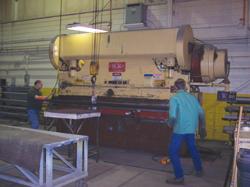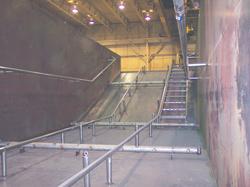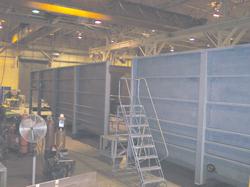Editor-in-Chief
- FMA
- The Fabricator
- FABTECH
- Canadian Metalworking
Categories
- Additive Manufacturing
- Aluminum Welding
- Arc Welding
- Assembly and Joining
- Automation and Robotics
- Bending and Forming
- Consumables
- Cutting and Weld Prep
- Electric Vehicles
- En Español
- Finishing
- Hydroforming
- Laser Cutting
- Laser Welding
- Machining
- Manufacturing Software
- Materials Handling
- Metals/Materials
- Oxyfuel Cutting
- Plasma Cutting
- Power Tools
- Punching and Other Holemaking
- Roll Forming
- Safety
- Sawing
- Shearing
- Shop Management
- Testing and Measuring
- Tube and Pipe Fabrication
- Tube and Pipe Production
- Waterjet Cutting
Industry Directory
Webcasts
Podcasts
FAB 40
Advertise
Subscribe
Account Login
Search
Doing what was always done doesn't cut it
Laser cutting does, however, and ABMyr, Belleville, Mich., believes the investment will pay off
- By Dan Davis
- July 1, 2010
- Article
- Shop Management

: Figure 1: Even though ABMyr is heavily involved in fabricating finishing and air processing systems for manufacturing OEMs, it still works with a range of metal thicknesses, from 20-gauge sheet to 0.5-in. plate. In this way it is like a typical job shop.
ABMyr Industries Inc. is a Michigan fabricator that’s survived one of the most difficult economic times ever for the state. ABMyr also happens to be a company that wached two of its major customers, Chrysler and GM, declare bankruptcy, something few ever thought was possible. Company Vice President Todd Marshke isn’t ready to throw in the towel, however. In fact, he’s cautiously optimistic about the future.
"There are more pluses than minuses," he said.
He has several reasons to be optimistic despite the fact that his company isn’t as large as it once was; it now runs only one shift with about 50 shop floor employees instead of the two shifts it had about two years ago. ABMyr is firmly entrenched as one of the leading companies for installing finishing and air processing systems for the automotive industry. The company has reached out beyond its traditional customer base and established good relations in other industry sectors, one of the more successful relationships being with John Deere. Investments have been made in design tools and fabricating equipment that could open the door to new fabricating opportunities. The company’s work force is experienced and talented, with almost everyone being skilled in welding, for example.
“We are very much in control of our costs even though we are a contract house. I know where I am at any point on any given day with [labor] hours and materials. We are really in tune with our costs and the projects," Marshke said. “I think we have made smart decisions as a company to weather the storm."
More Than Just a Fabricator
Marshke’s grandfather purchased what is known today as ABMyr from the widow of Arthur B. Myr in the 1940s. Under the conditions of the deal, the name remained the same even though the business plan soon changed.
The grandfather saw an opportunity for the light-gauge sheet metal shop. If it could align itself with the Detroit automakers, the company could ride the economic engine that was powering America in the early part of the century. That strategy proved sound as the company’s customer base was completely automotive-related for the better part of 50 years, according to Marshke.
During this time the company also developed its reputation as an expert in finishing and air processing systems (see Figure 1). The company holds patents on inline processing technology that can deliver up to 70 percent savings in energy usage when compared to typical instal- lations and oven controls that deliver optimal curing.
Also consider its means to remove paint from the racks that hold parts to be painted. Most finishing operations would just blast those racks with a 50,000-PSI washer to remove the paint from the metal, sending the paint flakes flying all over the place. Other shops push the racks into burnoff ovens where temperatures might reach 1,300 degrees before the flash point is reached and the paint vaporizes; the high temperatures also can affect the metallurgy of the racks’ components. ABMyr has developed a way to control both the temperature and the chamber’s humidity, which creates an environment where the paint can be burned off at a lower temperature and not warp the racks. That’s not a typical value-added offering from a typical fabricating shop.
It also helps to have six engineers on staff.
“I think one of the biggest differences from when my grandfather owned the business is that we have evolved into a full-system service integrator," Marshke said. “Fabrication is our core business, our foundation, our rock. It’s everything that we were in the beginning, but now we do so much with engineering, conveyor integration, robots, controls, air operations."
Installation is also a big part of ABMyr’s capabilities portfolio. The company will go just about anywhere to install its systems.
One of the most notable installations occurred in early 2008. ABMyr began the expansion and updating of an older paint shop with new finishing equipment at Toyota’s Woodstock, Ont., Canada, plant, one of the fabricator’s biggest jobs ever. Marshke estimated that ABMyr processed about 2.5 million pounds of metal through the shop in the 18 weeks it worked on the job.
The job was exciting not only from the standpoint that it was large and on an expedited schedule—"We always start out four weeks behind," Marshke said—but also because it was for a Japanese OEM. As a subcontractor on the job, ABMyr had developed a good working relationship with the bidding company. Marshke had heard different stories about working with companies such as Toyota, but in the end, everyone was pleased with the working relationship. He fully expects to work with Toyota again in the future.
Flexing the Design Muscle
It’s easy to see that ABMyr offers more than simple bending, cutting, and joining of metal components to create finishing-related structures (see Figure 2a and Figure 2b). It strives to use cutting-edge tools that give it an edge in executing its visions flawlessly.
One example is its investment and commitment to 3-D modeling. For the last 18 months, ABMyr engineers have dived into Autodesk® Inventor® 3D with the goal to model these finishing lines before they are installed and run.
“All things are errorproofed before you hit the floor, and things are easily manipulated in this system," Marshke said.
He described a model developed for a plastics customer that mimicked an observation deck overlooking a plastic molding line for automotive fascia, bumpers, and other parts. The deck was being fabricated to give inspectors clear vantage points to see any defective parts being manufactured on the line. ABMyr engineers were able to draw the entire line inside a virtual replica of the customer’s facility and animate an actual part moving through the shop floor. The model could be spun to offer another vantage point as well.
The 3-D modeling software is not only a valuable tool for customer conferences, but also an important part of ABMyr’s new standard line of finishing equipment. Marshke said they are close to completing a catalog of standard finishing equipment components that can be pulled together to form a complete system. He added that 3-D modeling gives the engineers the ability to “customize" a standard product, simply by making adjustments in the software. The software ensures all of the components change accordingly with the slightest adjustment in length or height of a product.
Currently four engineers are trained to work with the 3-D modeling software, and that training is very important because the software is very powerful. If a change is made to one part and the change is not done right, other models that contain that same part may be adversely affected.
Flexing the Fabricating Muscle
For the longest time, ABMyr relied on basic equipment to fabricate sheet metal for its many projects. Two shears and two old turret punch presses pretty much handled all of the cutting duties.

: Figure 2b: The tanks that ABMyr fabricates, such as this 38- by 12- by 11-foot prepaint rinse tank, can be very large. Scheduling is the key to producing these large fabrications efficiently in the company’s 65,000-square-foot shop.
Marshke said he had his eye on laser cutting equipment for some time, and the company’s board of directors finally approved the purchase in 2008. By September 2008 ABMyr was officially into laser cutting (see Figure 3).
The shears and turret punches were cleared out, and the steel storage area was moved to accommodate the two 4-kW laser cutting machines and the accompanying 16-shelf material storage tower. A 2-foot-thick concrete pad also had to be poured to provide a solid base for the precision fabricating equipment to do its work.
ABMyr, acting as a fabricator, tweaked its own equipment layout. The company designed its own mezzanine to keep the chilling and dust collection modules off the shop floor (see Figure 4).
When the metal forks used to load and unload the laser cutter started marking up some of the aluminum sheets, the company’s engineers considered ways to improve the equipment design. They tried Teflon® tape wrapped around the forks, but the wear and tear of the moving metal proved too much for the tape product. Someone suggested small brushes like you might find on the table of a new turret punch press (see Figure 5), and that made a lot of sense. Once the brushes were put into action, ABMyr’s manufacturing team realized they had a winning approach on their hands.
With the equipment up and running, the company also realized it had made a winning investment.
“When we first put the system in, and I had to unhook my shears and turrets … I would hear, ‘Man, all I need is a piece this big, I wish I had my shear. I could just shear it up and go,’"Marshke said. “It only took about three months when we really got into [the laser cutting machines], and I couldn’t figure out how we did business any other way. It was that dramatic."
The impact was immediate:
- ABMyr no longer had to outsource laser cutting. It had been spending about $30,000 a year to have parts laser-cut nearby.
- The company now could cut 1-in. carbon steel, which it could never do with its shears. This enabled it to pursue new customers and new markets.
- The company’s design philosophy changed as it related to its finishing and air processing systems. ABMyr could cut structural steel and use that thicker plate to act as a support for its industrial creations, instead of relying on a combination of small supports comprised of multiple sheet metal parts. As a result, less material was needed for jobs, and less time was needed to produce the parts for a job.
The lasers have the capability to run all night if needed because the material storage tower constantly feeds the equipment. Marshke said they have tried that on a limited basis, but that capability will come in handy should the company land the right combination of part orders.
Modernizing the Marketing Efforts
That’s where ABMyr is today: looking aggressively at other industries for potential customers. The simple fact of the matter is that business doesn’t just show up on the doorstep anymore.
That led the company’s leadership to reach out and hire a professional marketing firm. Jim Graziano, president, Onset Marketing, Wixom, Mich., has been working with them for several years and helped the company crack into new markets.
“We helped out with the strategic marketing infrastructure, as well as the branding and sales lead generation, to approach seven new markets,"Graziano said.
One of the new markets being targeted is the military, where the new laser cutting equipment will prove useful. ABMyr has attended many conferences, made the appropriate contacts, and placed several bids for work with military vehicle OEMs and subcontractors in the same supply chain, but the efforts have yet to pay off. Marshke said he is still optimistic because he has heard that once a company proves its worth to those large manufacturers, they continually feed work to their metal fabricating suppliers.
ABMyr has been in this position before as it looked to break away from its dependence on the automotive industry. The efforts paid off then as the company has become a trusted supplier to agricultural and heavy-duty equipment manufacturers and appliance-makers. For instance, the company just turned around a wash line and dryoff oven project for John Deere in a scant three months.
“Other people I don’t think can pull that off because they have certain bureaucracies. Basically, here you have executive management and then everybody else," Marshke said. “There isn’t any middle ground. We all do the work."
ABMyr has done all the work necessary to position itself for the rebound that will begin filling its pipeline with projects. Meanwhile, other fabricating competitors continue to do what they have always done, and that just doesn’t cut it nowadays.
About the Author

Dan Davis
2135 Point Blvd.
Elgin, IL 60123
815-227-8281
Dan Davis is editor-in-chief of The Fabricator, the industry's most widely circulated metal fabricating magazine, and its sister publications, The Tube & Pipe Journal and The Welder. He has been with the publications since April 2002.
Related Companies
subscribe now

The Fabricator is North America's leading magazine for the metal forming and fabricating industry. The magazine delivers the news, technical articles, and case histories that enable fabricators to do their jobs more efficiently. The Fabricator has served the industry since 1970.
start your free subscription- Stay connected from anywhere

Easily access valuable industry resources now with full access to the digital edition of The Fabricator.

Easily access valuable industry resources now with full access to the digital edition of The Welder.

Easily access valuable industry resources now with full access to the digital edition of The Tube and Pipe Journal.
- Podcasting
- Podcast:
- The Fabricator Podcast
- Published:
- 04/16/2024
- Running Time:
- 63:29
In this episode of The Fabricator Podcast, Caleb Chamberlain, co-founder and CEO of OSH Cut, discusses his company’s...
- Trending Articles
AI, machine learning, and the future of metal fabrication

Employee ownership: The best way to ensure engagement

Steel industry reacts to Nucor’s new weekly published HRC price

Dynamic Metal blossoms with each passing year

Metal fabrication management: A guide for new supervisors

- Industry Events
16th Annual Safety Conference
- April 30 - May 1, 2024
- Elgin,
Pipe and Tube Conference
- May 21 - 22, 2024
- Omaha, NE
World-Class Roll Forming Workshop
- June 5 - 6, 2024
- Louisville, KY
Advanced Laser Application Workshop
- June 25 - 27, 2024
- Novi, MI



























